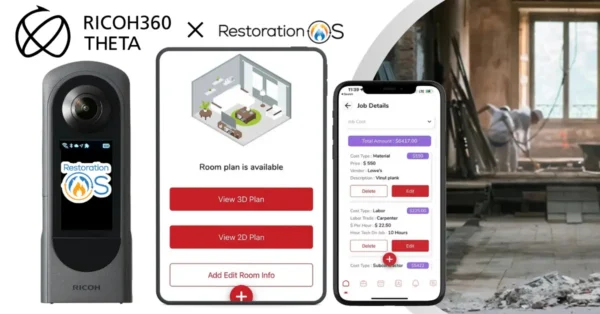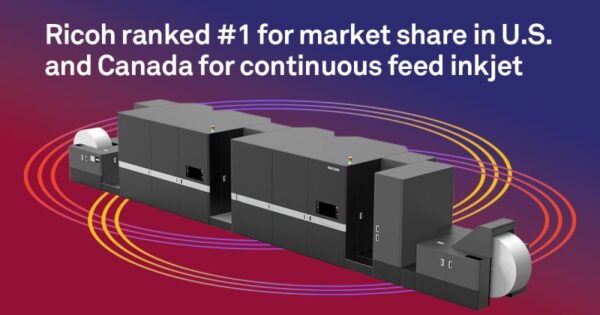Ricoh’s Gavin Jordan-Smith outlines the company’s present and future production and industrial print initiatives.
With the elimination of trade shows, conferences, and manufacturer and independent dealer group meetings due to the COVID-19 pandemic, we thought it would be a good idea to reach out to explore what is going on in the world of production print. The October PRINTING United Conference was replaced by the PRINTING United Digital Experience. The virtual format did not allow us to conduct personal interviews with exhibitors such as Ricoh USA. Instead, we connected with Ricoh’s Gavin Jordan-Smith, senior vice president, commercial and industrial printing business, to see what we could learn. Jordan-Smith has a long résumé and is well travelled and experienced in this area.
CR: This has been a difficult year for all of us. I was surprised to hear that many of the commercial printers we know are doing quite well. What is Ricoh’s experience with production print in general?
Jordan-Smith: We are seeing growth with many of our dealer partners, particularly in applications such as direct mail and the digital transition. We are also seeing growth in digital technology [capabilities] and the extensions to customer communication management—the control of applications that embrace this same digital transition.
CR: What are the leading applications for Ricoh’s production print customers?
Jordan-Smith: Inkjet in the transactional space. We are also seeing print-service providers working with our dealer partners to expand into the direct-mail digital experience. Aside from direct mail and marketing communication services, other applications include signage such as posters advising people to wear masks and maintain social distancing. Dealer partners are investing in business services tools for their showrooms. We are investing in the next generation of print, and it is very much a part of that story. Many dealers are investing in wide format and embracing services. Jim Coriddi [vice president of the dealer division, Ricoh] and his team have done a great job of getting dealers to invest in inkjet.
CR: This is the time of year (This interview was conducted in October.) when we usually anticipate attending PRINTING United. Did Ricoh have any plans for any major introductions? If so, what can you share with us about the new releases?
Jordan-Smith: There are a couple of things we wanted to show at PRINTING United. One was to convey the message that we are shifting into professional services. Another was the innovation employed inside the print devices we are now providing. For example, inside the Pro C7200, dealers have the option to obtain a fifth color via a subscription service. They only pay for what they use when they use it. In other words, dealers are paying for a four-color press and getting a fifth color. These things are making it easy for our dealer partners to shift into subscription-type services and professional services, including color management. We are talking more about software solutions/subscriptions—workflow coordination and making it accessible for the small and medium-sized dealer. Our focus is to enable our dealer partners to become successful around digital technology and digital services. We have every intention of succeeding in this new paradigm.
CR: 2021 is looking to be another challenging year. What are your group’s expectations in the new year?
Jordan-Smith: We have high expectations for 2021 that the digitization of everything, along with services and solutions, will lead to positive results. The reason for that optimism is that we are changing our approach on how we interact with customers. At the core of this adoption is a customer-flexible approach. We ask the question, what are the customer’s needs? It is obvious that COVID-19 is accelerating the need to embrace that process. We have changed how we go to market. We are using digital transformation. These are the things we are doing with our dealer partners. There are other challenges—how we adapt quickly and how scalable these adaptions are.
CR: Based on our Survey in which 69 Ricoh dealers participated, 60% indicated they were involved in production print. That percentage of affirmative responses seemed high when you compare it to the revenue being reported. What percentage of Ricoh dealers are engaged in production print?
Jordan-Smith: I would like to respond to this question by saying mega-dealers have different needs than medium-sized dealers. We are in over 60% of those mega-dealers. We are increasing our reach and signing on new medium-sized dealers. We have made the effort to take this COVID-19 period to work with those dealers. With small dealers, we support them through our dedicated people in the services area. Some of those small dealers have embraced those entry-level production products. They can do it, and Ricoh can help them by guiding the dealer in areas that are most difficult for them. This year, a greater number of small dealers are taking on production print, while many are refusing to hunker down due to the pandemic. Depending on the definition of “engaged in production print,” it is difficult to give an exact number.
CR: Inkjet technology has captured the large- and wide-format production area of the print industry. Do you believe that inkjet will replace the laser cut-sheet models?
Jordan-Smith: For us, inkjet is growing at a rate of 115%. It is only a matter of time that inkjet takes the lead over toner. However, toner is not going away. Inkjet technology is quicker and more advanced. We are seeing it come down in cost in an A3 format. We are going to see more of it in 2021. The reason I say toner is not going away, is because inkjet will have to improve the graphic quality capability before it could take market share from toner-based digital printers.
CR: What would your message be to the industry at large about the future of production print for the independent dealer?
Jordan-Smith: I see production and everything around it as an opportunity for the dealer. We are in a revolution of color interaction. I also believe in the future of production as we are going to manage printing pieces very differently. Some of that will shift digitally. It will not be a massive shift but a different type of printing. Dealers can take advantage. It will allow them to get into services, as well as the printing space. It is going to accelerate because that is where print is going.
CR: Is Ricoh anticipating conducting a meeting for their dealers in 2021, virtual or otherwise? If yes, when do you anticipate having it?
Jordan-Smith: I would hope that we can in our 2021 fiscal year, which starts April 1. Even if there is not a physical meeting during the calendar year, there will be something virtual. [To compensate,] we will continue to employ a high level of communication. We are going to do webinars. We held a virtual event this year with 100 of our dealers participating. Our fallback will be the virtual experience. We will not wait until this pandemic is over to expand our efforts to share all that we have in this space with our dealers.
CR: Thank you for sitting so long and responding to so many questions. Is there any message you would like to deliver to our readers about your expectations for 2021?
Jordan-Smith: Frank, it is always nice to chat with you and I appreciate the opportunity. We have a full production offering supported by an array of software that provides unique solutions. Due to the orientation of these new tools, Ricoh dealers can anticipate having an opportunity to grow their business in 2021.
Access Related Content
Visit the www.thecannatareport.com. To become a subscriber, visit www.thecannatareport.com/register or contact cjcannata@cannatareport.com directly. Bulk subscription rates are also available




